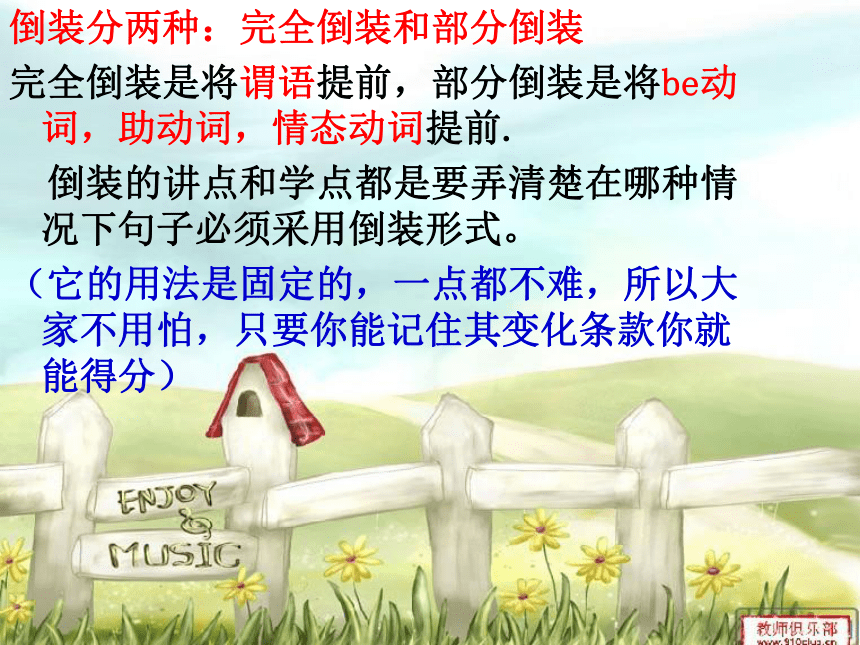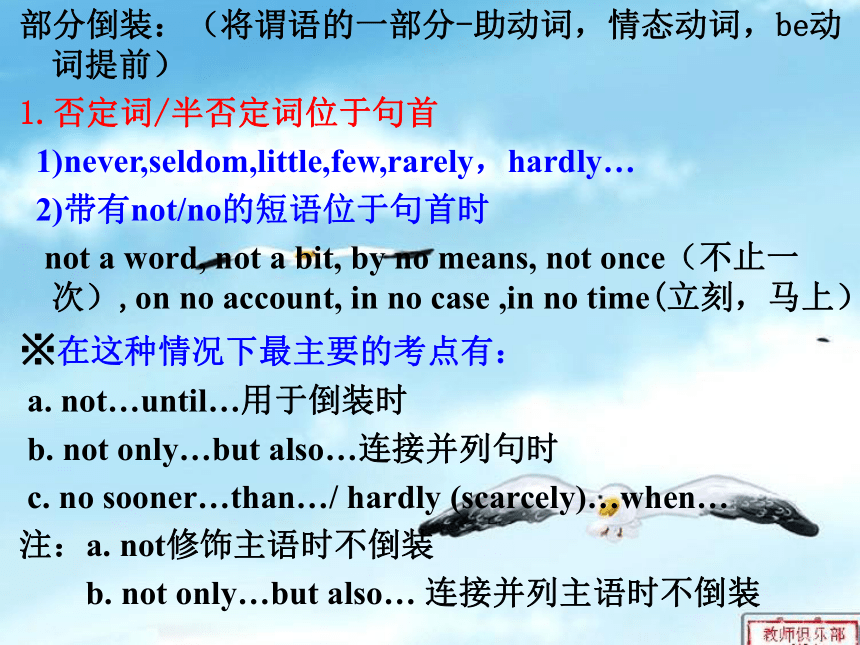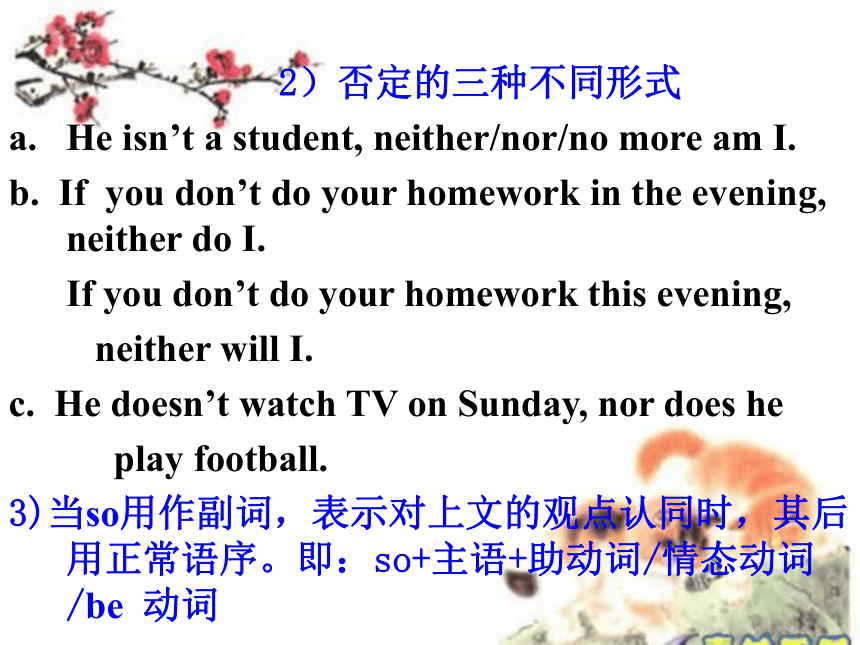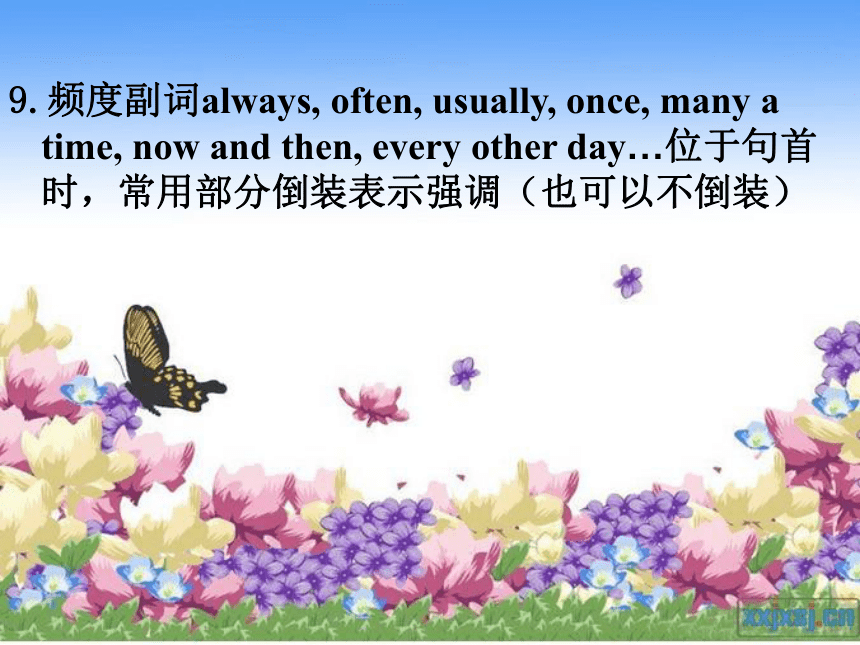【备战2014,教师原创】2014年高考英语语法备考 倒装 课件
文档属性
| 名称 | 【备战2014,教师原创】2014年高考英语语法备考 倒装 课件 |  | |
| 格式 | zip | ||
| 文件大小 | 884.5KB | ||
| 资源类型 | 教案 | ||
| 版本资源 | |||
| 科目 | 英语 | ||
| 更新时间 | 2014-03-24 19:40:04 | ||
图片预览







文档简介
课件15张PPT。 倒
装倒装分两种:完全倒装和部分倒装
完全倒装是将谓语提前,部分倒装是将be动词,助动词,情态动词提前.
倒装的讲点和学点都是要弄清楚在哪种情况下句子必须采用倒装形式。
(它的用法是固定的,一点都不难,所以大家不用怕,只要你能记住其变化条款你就能得分)部分倒装:(将谓语的一部分-助动词,情态动词,be动词提前)
1.否定词/半否定词位于句首
1)never,seldom,little,few,rarely,hardly…
2)带有not/no的短语位于句首时
not a word, not a bit, by no means, not once(不止一次),on no account, in no case ,in no time(立刻,马上)
※在这种情况下最主要的考点有:
a. not…until…用于倒装时
b. not only…but also…连接并列句时
c. no sooner…than…/ hardly (scarcely)…when…
注:a. not修饰主语时不倒装
b. not only…but also… 连接并列主语时不倒装
2.no构成的合成代词或副词位于
句首作宾语或状语时
nobody, nothing, nowhere, nohow (毫不,
绝不,无论如何不)
a. Nothing did the boy learn in class.
b. Nowhere can you find me.
c. Nobody did I see there.
但是:Nobody saw me there.
3.so…that…/such…that… 句型中,将so…/such…部分位于句首时,前面的句子部分倒装
4.在条件虚拟语气中省掉if将had/should/were提前
5.only+状语/状语从句位于句首时
6.as/though引导的让步状语从句
7.在肯定句中,后一分句符合前一分句的情况,用so+助动词/情态动词/be动词+主语
8.在否定句中,后一分句符合前一分句的情况,用neither/nor/no more+助动词/情态动词/be动词+主语
但是:要注意以下情况
1)前一分句是个并列句时,后一分句符合前一分句的情况,要用 So it is with…/It is the same with…
2)否定的三种不同形式
He isn’t a student, neither/nor/no more am I.
b. If you don’t do your homework in the evening, neither do I.
If you don’t do your homework this evening,
neither will I.
c. He doesn’t watch TV on Sunday, nor does he
play football.
3)当so用作副词,表示对上文的观点认同时,其后用正常语序。即:so+主语+助动词/情态动词 /be 动词
9.频度副词always, often, usually, once, many a time, now and then, every other day…位于句首时,常用部分倒装表示强调(也可以不倒装)全部倒装:将谓语提前。
1.为了表示强调或者为了保持句子平衡,谓语中的分词、形容词或者动词不定式常被提到句首
1)Gone are the days when we used the foreign oil.
2)Surrounding the earth is the air of unknown thickness.
3)Lying under the tree were some apples.
4)Present at the meeting were two professors.
5)Hanging on the wall was a painting by her brother.
6)To devote ourselves to society is our duty.
2.以引导词there引出倒装句,常用此结构的动词有:
be, exist, lie,stand, happen
live, flow, occur, seem …
1)There seems to be…
2)There happens to be...
3)There lies/flows/stands/exists/…
3.here,there,now,then位于句首时
1)Now comes your turn.
2)Then appeared a loud noise.
3)Here comes the bus.
The bus is coming.
4)There goes the bell.
The bell is ringing.
但是:当主语是人称代词时,不能倒装
1)Here it is.
2)There we are.
3)Here he comes.4.in, out ,away, off, up, down等方位副词位于句首时
(这时谓语动词常是come,go,fall,rush等)
1)Away went Tom.
2)In came the teacher.
3)Down climbed Jack.
4)Out rushed the student.
但:主语是人称代词时不能倒装
1)Away he went.
2)In he came.
3)Down we climbed.
4)Out they rushed.5.表地点的介词/副词短语放在句首时
(这时谓语为不及物动词be,sit,stand,lie等)
1)South of the city lies a park.
2)On top of the hill stands an old tree.
3)In front of the house sits a boy.
4)In the classroom are five students.
5)From the house came a frightening noise.
6)It is our building,on top of which is flying a flag.
注意:
以上倒装句适合于无宾语(主语有时且很长)的情况。但如果主语是人称代词时则不倒装。
1)In front of the house is standing the boy.
2) In front of the house he is standing.
3)Inside the pyramid are the burial rooms for the kings.6.as/so…as(尽管)引导让步状语从句需倒装
1)As much as I’d like to seeyou=Even though I’d like to see you much,you can’t come.
2)As poor as he is ,he never gives up.
3)As horrible as it was,SARS was not strong enough to break the determinatoin of the Chinese people.Bye
Good luck!
装倒装分两种:完全倒装和部分倒装
完全倒装是将谓语提前,部分倒装是将be动词,助动词,情态动词提前.
倒装的讲点和学点都是要弄清楚在哪种情况下句子必须采用倒装形式。
(它的用法是固定的,一点都不难,所以大家不用怕,只要你能记住其变化条款你就能得分)部分倒装:(将谓语的一部分-助动词,情态动词,be动词提前)
1.否定词/半否定词位于句首
1)never,seldom,little,few,rarely,hardly…
2)带有not/no的短语位于句首时
not a word, not a bit, by no means, not once(不止一次),on no account, in no case ,in no time(立刻,马上)
※在这种情况下最主要的考点有:
a. not…until…用于倒装时
b. not only…but also…连接并列句时
c. no sooner…than…/ hardly (scarcely)…when…
注:a. not修饰主语时不倒装
b. not only…but also… 连接并列主语时不倒装
2.no构成的合成代词或副词位于
句首作宾语或状语时
nobody, nothing, nowhere, nohow (毫不,
绝不,无论如何不)
a. Nothing did the boy learn in class.
b. Nowhere can you find me.
c. Nobody did I see there.
但是:Nobody saw me there.
3.so…that…/such…that… 句型中,将so…/such…部分位于句首时,前面的句子部分倒装
4.在条件虚拟语气中省掉if将had/should/were提前
5.only+状语/状语从句位于句首时
6.as/though引导的让步状语从句
7.在肯定句中,后一分句符合前一分句的情况,用so+助动词/情态动词/be动词+主语
8.在否定句中,后一分句符合前一分句的情况,用neither/nor/no more+助动词/情态动词/be动词+主语
但是:要注意以下情况
1)前一分句是个并列句时,后一分句符合前一分句的情况,要用 So it is with…/It is the same with…
2)否定的三种不同形式
He isn’t a student, neither/nor/no more am I.
b. If you don’t do your homework in the evening, neither do I.
If you don’t do your homework this evening,
neither will I.
c. He doesn’t watch TV on Sunday, nor does he
play football.
3)当so用作副词,表示对上文的观点认同时,其后用正常语序。即:so+主语+助动词/情态动词 /be 动词
9.频度副词always, often, usually, once, many a time, now and then, every other day…位于句首时,常用部分倒装表示强调(也可以不倒装)全部倒装:将谓语提前。
1.为了表示强调或者为了保持句子平衡,谓语中的分词、形容词或者动词不定式常被提到句首
1)Gone are the days when we used the foreign oil.
2)Surrounding the earth is the air of unknown thickness.
3)Lying under the tree were some apples.
4)Present at the meeting were two professors.
5)Hanging on the wall was a painting by her brother.
6)To devote ourselves to society is our duty.
2.以引导词there引出倒装句,常用此结构的动词有:
be, exist, lie,stand, happen
live, flow, occur, seem …
1)There seems to be…
2)There happens to be...
3)There lies/flows/stands/exists/…
3.here,there,now,then位于句首时
1)Now comes your turn.
2)Then appeared a loud noise.
3)Here comes the bus.
The bus is coming.
4)There goes the bell.
The bell is ringing.
但是:当主语是人称代词时,不能倒装
1)Here it is.
2)There we are.
3)Here he comes.4.in, out ,away, off, up, down等方位副词位于句首时
(这时谓语动词常是come,go,fall,rush等)
1)Away went Tom.
2)In came the teacher.
3)Down climbed Jack.
4)Out rushed the student.
但:主语是人称代词时不能倒装
1)Away he went.
2)In he came.
3)Down we climbed.
4)Out they rushed.5.表地点的介词/副词短语放在句首时
(这时谓语为不及物动词be,sit,stand,lie等)
1)South of the city lies a park.
2)On top of the hill stands an old tree.
3)In front of the house sits a boy.
4)In the classroom are five students.
5)From the house came a frightening noise.
6)It is our building,on top of which is flying a flag.
注意:
以上倒装句适合于无宾语(主语有时且很长)的情况。但如果主语是人称代词时则不倒装。
1)In front of the house is standing the boy.
2) In front of the house he is standing.
3)Inside the pyramid are the burial rooms for the kings.6.as/so…as(尽管)引导让步状语从句需倒装
1)As much as I’d like to seeyou=Even though I’d like to see you much,you can’t come.
2)As poor as he is ,he never gives up.
3)As horrible as it was,SARS was not strong enough to break the determinatoin of the Chinese people.Bye
Good luck!
